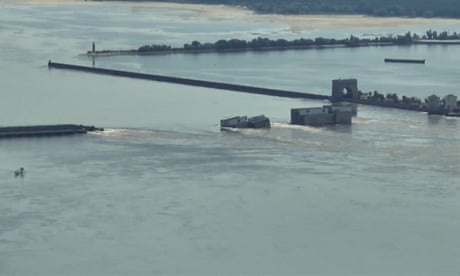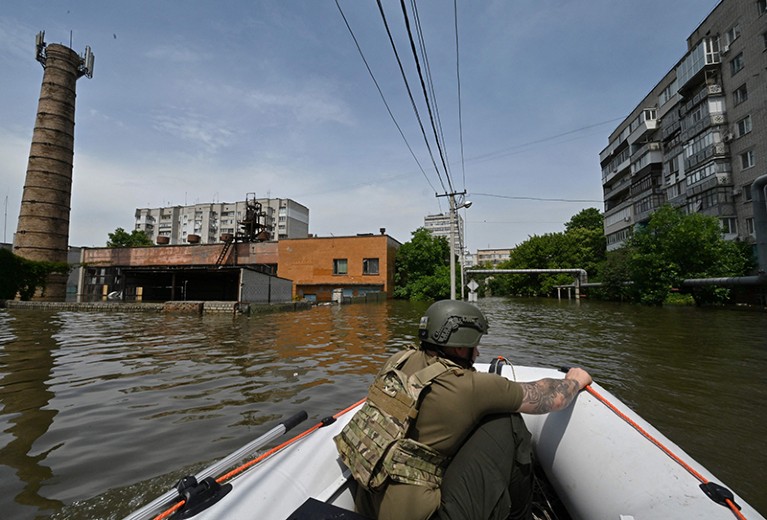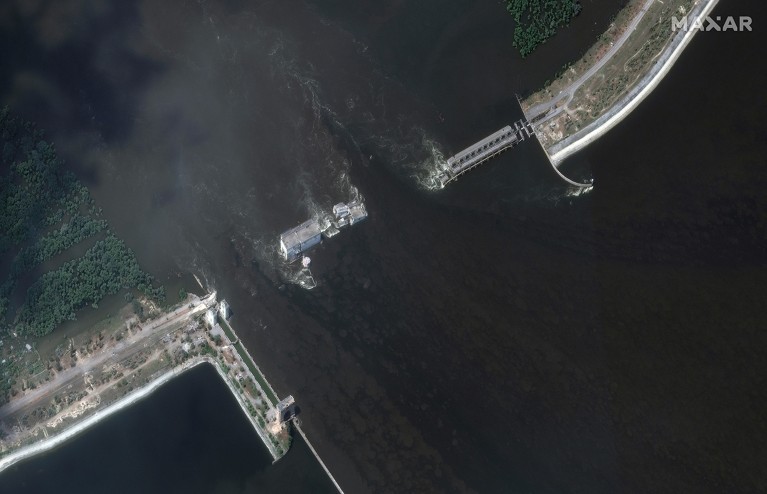Reuters
June 13, 2023


International Atomic Energy Agency (IAEA) Director General Rafael Grossi holds a press conference, amid Russia's attack on Ukraine, in Kyiv, Ukraine June 13, 2023.
REUTERS/Valentyn Ogirenko
Summary
Summary
Nuclear chief to visit plant on Tuesday evening
Situation 'serious' but no immediate danger
Water level enough to meet nuclear plant's needs
No sign Russia moving military equipment to plant
KYIV, June 13 (Reuters) - U.N. nuclear chief Rafael Grossi visited Kyiv on Tuesday, where he met President Volodymyr Zelenskiy before travelling to Ukraine's Russian-occupied Zaporizhzhia nuclear plant near where a huge river dam was destroyed last week.
The International Atomic Energy Agency (IAEA) said on Sunday it needed access to a site near the plant to check water levels after the reservoir lost a large portion of its water because of the destruction of the Kakhovka dam downstream.
Both sides have accused each other of sabotaging the dam, leading to catastrophic flooding. Western countries say they are still gathering evidence but believe Ukraine would have had no reason to inflict such a disaster on itself.
Russian forces captured the hydroelectric dam and the nuclear plant in southern Ukraine shortly after their February 2022 invasion.
The Zaporizhzhia nuclear plant uses a cooling pond to keep its six reactors from potentially disastrous overheating.
Ukraine's nuclear energy company said on Tuesday that the level of the pond was stable and that the water was high enough.
As of Tuesday morning, the water level stood at 16.67 metres (54.69 feet), which Energoatom said was "quite enough to meet the needs of the station".
Speaking to reporters in Kyiv, Grossi said there was no immediate danger but that it was a "serious situation".
"It is a step in the wrong direction," he said. "It is yet another step into the weakening of the safety net that one has in any nuclear power plant."
Grossi said his visit to the facility, Europe's largest, on Tuesday evening would provide a more accurate assessment of the risk.
The Kakhovka reservoir was normally used to refill the pond but cannot do so now because of its falling water level, Ukrainian nuclear authorities have said.
Instead, the pond, which is separated from the reservoir, can be replenished using deep underground wells, they said.
The water in the pond is also expended very slowly because the reactors are not producing power and water does not evaporate quickly during the cooling process.
Grossi also said he was "very concerned" that the nuclear plant could be caught in Ukraine's counteroffensive to retake Russian-occupied territory.
He added that there was no sign Russian forces had moved heavy military equipment to the site, but that his visit would aim to clarify that.
"We do not have any indication at this point, but it could not be excluded," he said.
Reporting by Anna Pruchnicka and Dan Peleschuk; editing by Tom Balmforth, Gareth Jones, Mark Heinrich & Conor Humphries
UN concerned by ‘discrepancy’ in Ukraine nuclear plant water levels after dam collapse
IAEA head Rafael Grossi, who will visit Zaporizhzhia nuclear plant, says there is a difference of about 2 metres from the reservoir that cools the plant
Reuters
Mon 12 Jun 2023
The UN atomic watchdog has said it needs wider access around the Zaporizhzhia nuclear plant to check “a significant discrepancy” in water level data at the breached Kakhovka dam used for cooling the plant’s reactors.
International Atomic Energy Agency head Rafael Grossi, who is to visit the plant this week, said that measurements the agency received from the inlet of the plant showed that the dam’s water levels were stable for about a day over the weekend.
“However, the height is reportedly continuing to fall elsewhere in the huge reservoir, causing a possible difference of about 2 metres,” Grossi said in a statement.

A visual guide to the collapse of Ukraine’s Nova Kakhovka dam
“The height of the water level is a key parameter for the continued operability of the water pumps”.
The water from the reservoir is used to cool the facility’s six reactors and spent fuel storage, the IAEA said.
The agency has said earlier that the Zaporizhzhia plant can fall back on other water sources when the reservoir’s water is no longer available, including a large cooling pond above the reservoir with several months’ worth of water.
The destruction of the Kakhovka hydropower dam in southern Ukraine last week has flooded towns downstream and forced thousands of people from their homes.
Both the Kakhovka hydropower dam and the Zaporizhzhia nuclear plant have been occupied by Russia since the early days of its invasion in February 2022.
“It is possible that this discrepancy in the measured levels is caused by an isolated body of water separated from the larger body of the reservoir,” Gross said in the statement. “But we will only be able to know when we gain access to the thermal power plant.”
Grossi said the thermal power plant “plays a key role for the safety and security of the nuclear power plant a few kilometres away,” hence the need for access and independent assessment.
IAEA head Rafael Grossi, who will visit Zaporizhzhia nuclear plant, says there is a difference of about 2 metres from the reservoir that cools the plant
Reuters
Mon 12 Jun 2023
The UN atomic watchdog has said it needs wider access around the Zaporizhzhia nuclear plant to check “a significant discrepancy” in water level data at the breached Kakhovka dam used for cooling the plant’s reactors.
International Atomic Energy Agency head Rafael Grossi, who is to visit the plant this week, said that measurements the agency received from the inlet of the plant showed that the dam’s water levels were stable for about a day over the weekend.
“However, the height is reportedly continuing to fall elsewhere in the huge reservoir, causing a possible difference of about 2 metres,” Grossi said in a statement.

A visual guide to the collapse of Ukraine’s Nova Kakhovka dam
“The height of the water level is a key parameter for the continued operability of the water pumps”.
The water from the reservoir is used to cool the facility’s six reactors and spent fuel storage, the IAEA said.
The agency has said earlier that the Zaporizhzhia plant can fall back on other water sources when the reservoir’s water is no longer available, including a large cooling pond above the reservoir with several months’ worth of water.
The destruction of the Kakhovka hydropower dam in southern Ukraine last week has flooded towns downstream and forced thousands of people from their homes.
Both the Kakhovka hydropower dam and the Zaporizhzhia nuclear plant have been occupied by Russia since the early days of its invasion in February 2022.
“It is possible that this discrepancy in the measured levels is caused by an isolated body of water separated from the larger body of the reservoir,” Gross said in the statement. “But we will only be able to know when we gain access to the thermal power plant.”
Grossi said the thermal power plant “plays a key role for the safety and security of the nuclear power plant a few kilometres away,” hence the need for access and independent assessment.
Ukraine dam collapse: what scientists are watching
Extensive flooding could have severe consequences for farming, health and the environment.
Miryam Naddaf
NEWS EXPLAINER
What are some of the immediate consequences?
Before the breach, the Kakhovka reservoir held more than 19 cubic kilometres of water. “Now, there are only 11 cubic kilometres of water left,” said Oleksandr Krasnolutskyi, Ukraine’s deputy minister of environmental protection and natural resources, in Kyiv, at a press briefing on 8 June.
The reservoir provides water for more than 700,000 people in south Ukraine. Cities on the Dnieper River, including Kherson, Nikopol, Marhanets and Pokrov, are short of water supplies, according to the United Nations.
And the flood waters themselves have caused extensive damage — destroying houses, roads and other crucial infrastructure.
How might the flooding affect farming and food security?
As the water level continues to drop, there will not be enough water for the irrigation canals that the reservoir usually serves, says Roger Falconer, a water engineer at Cardiff University, UK, who specializes in modelling dam failures. “It could affect crops both downstream and upstream.”
Flood water has inundated large areas of farms and arable lands, washing away their topsoil layers, according to Ukraine’s environment ministry. “We will not be able to cultivate agricultural plants on this soil for many years,” said Krasnolutskyi. Falconer adds that the floods could wash fertilizers used on agricultural land into the river, where they could disrupt aquatic ecosystems.
What are the other environmental impacts?
The sudden surge of water downstream has had immediate and far-reaching impacts on the biodiverse ecosystems. “Nearly 160,000 animals and 20,000 birds are under threat because of the catastrophe,” said Krasnolutskyi.
Some of those species are rare, or found only in this area. These include the vulnerable Nordmann’s birch mouse (Sicista loriger) and the endangered sand mole rat (Spalax arenarius), according to a report by the Ukrainian Nature Conservation Group (UNCG) in Vasylkiv.
The Kakhovka reservoir itself is home to dozens of fish species. The rapid draining of its water means that vast numbers of fish will be either stranded in shallow, dried-up zones, or swept away to sea, where they will perish in the salt water.
“What we have seen is the tip of the iceberg,” says Oleksii Vasyliuk, an environmentalist and co-founder of UNCG. “This is ecocide.”
Nearby national parks have also been flooded, which will cause irreparable damage to their flora and fauna.
Nine sites in Ukraine’s Emerald Network, a Europe-wide conserved area, as well as five internationally important wetlands have been flooded. Around 55,000 hectares of forest have been inundated with water that is predicted to remain stagnant for 20 days, according to the environment ministry.

A member of Ukraine’s National Guard brings food to Kherson residents stranded by flooding.
Does the dam’s proximity to a nuclear power plant pose a danger?
Europe’s largest nuclear power plant, in Zaporizhzhia, is located around 150 kilometres upstream of the Kakhovka dam. The plant’s six reactors have been shut down for more than eight months — but it needs cooling water to manage the residual decay heat. The reactor is continuing to pump cooling water in from the reservoir, according to the International Atomic Energy Agency.
If the water level in the Kakhovka reservoir drops too low to be able to supply cooling water, Zaporizhzhia can switch to alternative water supplies. There are also two cooling towers that use the atmosphere for cooling, and require only a small amount of water to operate, says Malte Jansen, an energy scientist at the University of Sussex in Brighton, UK.
Perhaps more concerning is the potential dispersal of toxic compounds. More than 150 tonnes of machine oil from the Kakhovka hydroelectric power station, which sits on the dam, have spilled into the Dnieper River, according to the environment ministry. The flood water also carried garbage, together with construction waste and sewage, into the Dnieper watershed, according to Krasnolutskyi, where it could potentially contaminate supplies of drinking water.
What can be done to address the situation?
If the reservoir’s water level continues to fall, it will eventually return to the baseline level before the dam was built, says Falconer.
He adds that the collapse will ultimately change the reservoir’s bed topography, and that it could also increase shear stress, the force of water flowing against the river bed, which would disturb any toxic sediment there.
“It will be necessary to either plant [upstream] areas with a forest, or sow meadow grasses so that the wind does not blow away this silt at the bottom of the dried reservoir, because it is contaminated with waste from Zaporizhzhia,” says Vasyliuk.
The environment ministry says that a scientific survey will be needed to explore whether the dam should be rebuilt. But a complete assessment of the flood’s impact is unlikely at present: Russian forces currently control the south side of the river, where most of the flooding has occurred. “Nothing can be done to minimize the consequences,” says Vasyliuk. “This is a zone of both an environmental disaster and active hostilities.”
Nature 618, 440-441 (2023)
https://doi.org/10.1038/d41586-023-01928-8
Extensive flooding could have severe consequences for farming, health and the environment.
Miryam Naddaf
NEWS EXPLAINER
NATURE
09 June 2023

Large sections of the Kakhovka dam have collapsed, unleashing catastrophic floods. Credit: Satellite image (c) 2023 Maxar Technologies via Getty
The 66-year-old Kakhovka dam on the Dnieper River in south Ukraine collapsed on the morning of 6 June after a suspected explosion, triggering a catastrophic humanitarian and environmental crisis.
Spanning an area of more than 2,000 square kilometres, the dam’s reservoir is the country’s largest in terms of water volume. The dam has been controlled by Russian forces for more than a year.
The breach triggered extensive flooding, which peaked at a depth of 5.6 metres in Kherson on 8 June and has already displaced more than 20,000 people across dozens of settlements, including in Russian-held areas on the river’s lower-left bank. The deluge is expected to continue for at least a week.
Nature spoke to researchers and specialists on rivers and environmental science about the continuing impacts of the disaster.
09 June 2023

Large sections of the Kakhovka dam have collapsed, unleashing catastrophic floods. Credit: Satellite image (c) 2023 Maxar Technologies via Getty
The 66-year-old Kakhovka dam on the Dnieper River in south Ukraine collapsed on the morning of 6 June after a suspected explosion, triggering a catastrophic humanitarian and environmental crisis.
Spanning an area of more than 2,000 square kilometres, the dam’s reservoir is the country’s largest in terms of water volume. The dam has been controlled by Russian forces for more than a year.
The breach triggered extensive flooding, which peaked at a depth of 5.6 metres in Kherson on 8 June and has already displaced more than 20,000 people across dozens of settlements, including in Russian-held areas on the river’s lower-left bank. The deluge is expected to continue for at least a week.
Nature spoke to researchers and specialists on rivers and environmental science about the continuing impacts of the disaster.
What are some of the immediate consequences?
Before the breach, the Kakhovka reservoir held more than 19 cubic kilometres of water. “Now, there are only 11 cubic kilometres of water left,” said Oleksandr Krasnolutskyi, Ukraine’s deputy minister of environmental protection and natural resources, in Kyiv, at a press briefing on 8 June.
The reservoir provides water for more than 700,000 people in south Ukraine. Cities on the Dnieper River, including Kherson, Nikopol, Marhanets and Pokrov, are short of water supplies, according to the United Nations.
And the flood waters themselves have caused extensive damage — destroying houses, roads and other crucial infrastructure.
How might the flooding affect farming and food security?
As the water level continues to drop, there will not be enough water for the irrigation canals that the reservoir usually serves, says Roger Falconer, a water engineer at Cardiff University, UK, who specializes in modelling dam failures. “It could affect crops both downstream and upstream.”
Flood water has inundated large areas of farms and arable lands, washing away their topsoil layers, according to Ukraine’s environment ministry. “We will not be able to cultivate agricultural plants on this soil for many years,” said Krasnolutskyi. Falconer adds that the floods could wash fertilizers used on agricultural land into the river, where they could disrupt aquatic ecosystems.
What are the other environmental impacts?
The sudden surge of water downstream has had immediate and far-reaching impacts on the biodiverse ecosystems. “Nearly 160,000 animals and 20,000 birds are under threat because of the catastrophe,” said Krasnolutskyi.
Some of those species are rare, or found only in this area. These include the vulnerable Nordmann’s birch mouse (Sicista loriger) and the endangered sand mole rat (Spalax arenarius), according to a report by the Ukrainian Nature Conservation Group (UNCG) in Vasylkiv.
The Kakhovka reservoir itself is home to dozens of fish species. The rapid draining of its water means that vast numbers of fish will be either stranded in shallow, dried-up zones, or swept away to sea, where they will perish in the salt water.
“What we have seen is the tip of the iceberg,” says Oleksii Vasyliuk, an environmentalist and co-founder of UNCG. “This is ecocide.”
Nearby national parks have also been flooded, which will cause irreparable damage to their flora and fauna.
Nine sites in Ukraine’s Emerald Network, a Europe-wide conserved area, as well as five internationally important wetlands have been flooded. Around 55,000 hectares of forest have been inundated with water that is predicted to remain stagnant for 20 days, according to the environment ministry.

A member of Ukraine’s National Guard brings food to Kherson residents stranded by flooding.
Credit: Genya Savilov/AFP via Getty
Does the dam’s proximity to a nuclear power plant pose a danger?
Europe’s largest nuclear power plant, in Zaporizhzhia, is located around 150 kilometres upstream of the Kakhovka dam. The plant’s six reactors have been shut down for more than eight months — but it needs cooling water to manage the residual decay heat. The reactor is continuing to pump cooling water in from the reservoir, according to the International Atomic Energy Agency.
If the water level in the Kakhovka reservoir drops too low to be able to supply cooling water, Zaporizhzhia can switch to alternative water supplies. There are also two cooling towers that use the atmosphere for cooling, and require only a small amount of water to operate, says Malte Jansen, an energy scientist at the University of Sussex in Brighton, UK.
Perhaps more concerning is the potential dispersal of toxic compounds. More than 150 tonnes of machine oil from the Kakhovka hydroelectric power station, which sits on the dam, have spilled into the Dnieper River, according to the environment ministry. The flood water also carried garbage, together with construction waste and sewage, into the Dnieper watershed, according to Krasnolutskyi, where it could potentially contaminate supplies of drinking water.
What can be done to address the situation?
If the reservoir’s water level continues to fall, it will eventually return to the baseline level before the dam was built, says Falconer.
He adds that the collapse will ultimately change the reservoir’s bed topography, and that it could also increase shear stress, the force of water flowing against the river bed, which would disturb any toxic sediment there.
“It will be necessary to either plant [upstream] areas with a forest, or sow meadow grasses so that the wind does not blow away this silt at the bottom of the dried reservoir, because it is contaminated with waste from Zaporizhzhia,” says Vasyliuk.
The environment ministry says that a scientific survey will be needed to explore whether the dam should be rebuilt. But a complete assessment of the flood’s impact is unlikely at present: Russian forces currently control the south side of the river, where most of the flooding has occurred. “Nothing can be done to minimize the consequences,” says Vasyliuk. “This is a zone of both an environmental disaster and active hostilities.”
Nature 618, 440-441 (2023)
https://doi.org/10.1038/d41586-023-01928-8
No comments:
Post a Comment